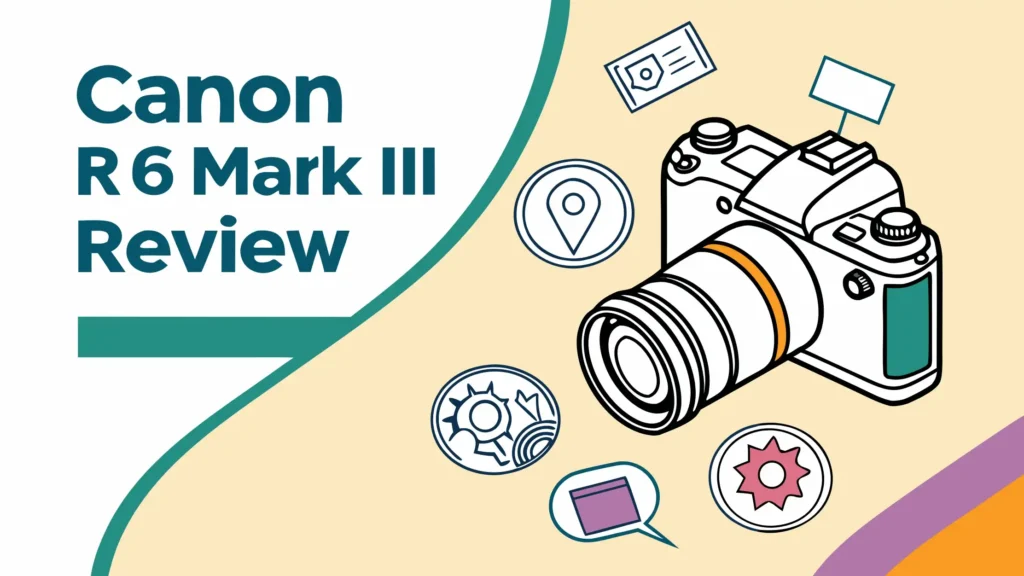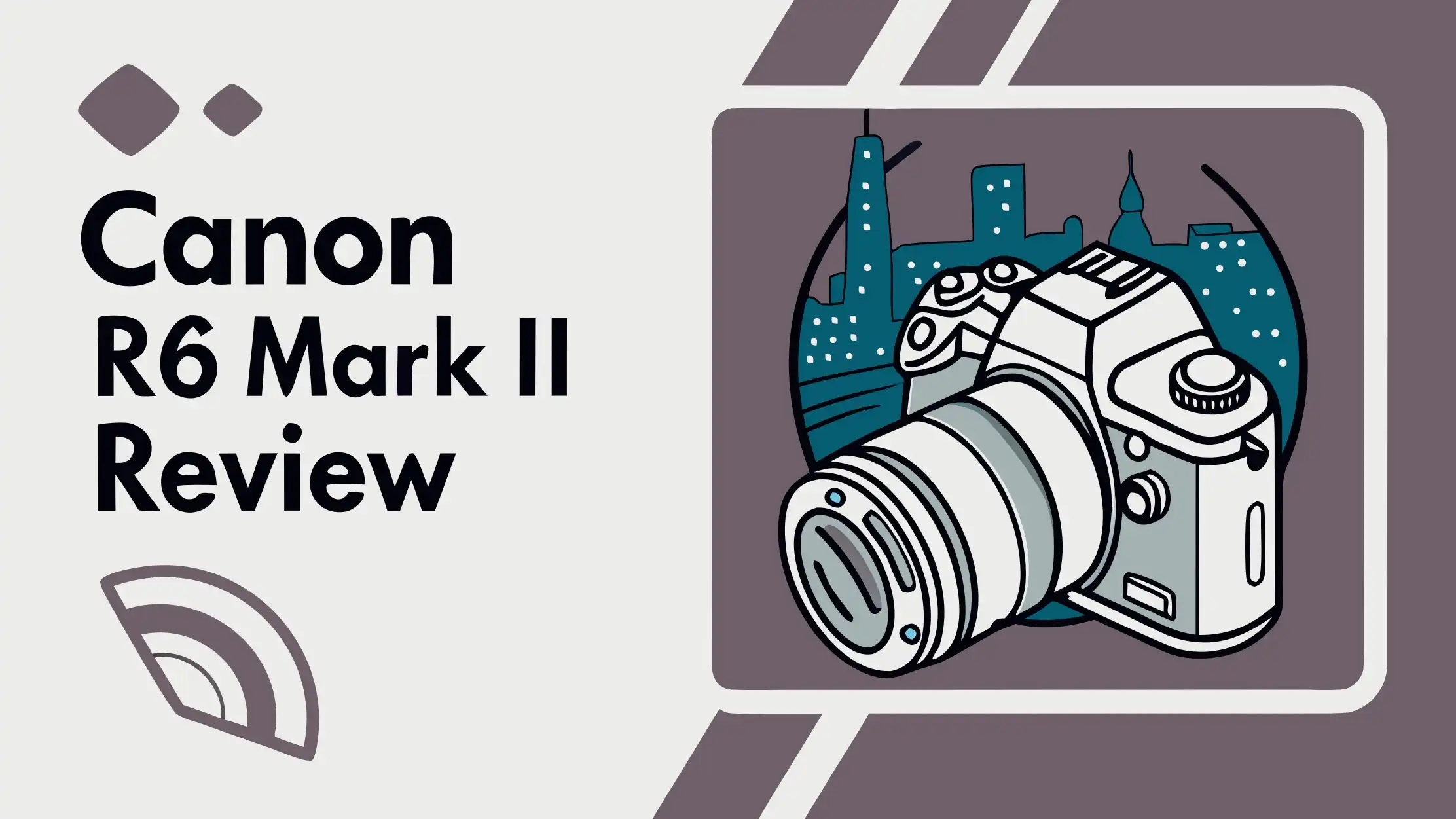Canon EOS R6 Mark II Review: Still the Best Hybrid Camera?
The Canon EOS R6 Mark II stands as one of the most impressive full frame mirrorless cameras in 2024. This camera combines exceptional image quality with advanced video capabilities and lightning fast autofocus performance.
The R6 Mark II represents Canon’s commitment to innovation while maintaining the user friendly experience that photographers love.
The camera market continues to evolve rapidly, and the R6 Mark II positions itself as a serious contender against competitors like Sony and Nikon.

Key Takeaways
- Enhanced 24.2MP Sensor: The camera features an upgraded full frame sensor that delivers excellent image quality with improved dynamic range and low light performance compared to its predecessor
- Lightning Fast Autofocus: The Dual Pixel CMOS AF system provides 100% frame coverage with advanced subject tracking capabilities that lock onto people, animals, and vehicles with remarkable precision
- Impressive Burst Shooting: Capture action at 12fps with mechanical shutter or push it to 40fps with electronic shutter, making it perfect for sports and wildlife photography
- Professional Video Features: Record stunning 4K video at 60fps with 6K oversampling, plus high speed 1080p at 180fps for slow motion effects that add cinematic quality to your projects
- Advanced Image Stabilization: The 8 stop in body image stabilization system works seamlessly with compatible RF lenses to deliver sharp handheld shots even in challenging conditions
- Robust Build Quality: Weather sealed construction with magnesium alloy body ensures reliable performance in various environmental conditions while maintaining comfortable ergonomics for extended shooting sessions
Canon EOS R6 Mark II Specifications and Build Quality
No products found.
The Canon R6 Mark II features a robust magnesium alloy construction that feels substantial in your hands. The camera weighs approximately 588 grams without battery and memory card, making it comfortable for extended shooting sessions. The weather sealing protects against dust and moisture, allowing you to shoot confidently in challenging outdoor conditions.
The ergonomics receive significant praise from photographers who use the camera professionally. The grip provides excellent comfort and security, while the button layout feels intuitive and well thought out. The 3.2 inch vari angle touchscreen offers bright, clear visibility even in direct sunlight. The electronic viewfinder delivers 3.69 million dots with smooth refresh rates that make manual focusing and composition effortless.
Canon has positioned the controls strategically to minimize menu diving during shoots. The dual control dials and customizable buttons allow quick access to frequently used settings. The battery life extends to approximately 760 shots per charge using the viewfinder, which outperforms many competitors in this category. The dual card slots accept both CFexpress Type B and SD cards, providing flexibility for different workflows and backup requirements.
Image Quality and Sensor Performance
The 24.2 megapixel full frame CMOS sensor represents a modest but meaningful upgrade from the original R6’s 20 megapixels. This increase provides additional cropping flexibility while maintaining excellent low light performance. The sensor demonstrates impressive dynamic range that recovers shadow and highlight details effectively during post processing.
Low light capabilities shine particularly bright with the R6 Mark II. The camera produces clean, usable images at ISO 6400 with minimal noise reduction required. Push the sensitivity to ISO 12800 and the results remain surprisingly good for most applications. The highest ISO 102400 setting works well for emergency situations where capturing the moment matters more than absolute image quality.
Color reproduction follows Canon’s signature look with pleasing skin tones and vibrant yet natural colors. The camera handles mixed lighting situations well, and the white balance system rarely produces significant color casts. The 14 bit RAW files provide excellent latitude for post processing adjustments, making them ideal for professional workflows that demand maximum image quality and flexibility.
Autofocus System and Tracking Performance
The Dual Pixel CMOS AF system in the R6 Mark II sets new standards for accuracy and reliability. With 1053 automatic AF points covering 100% of the frame, the camera locks onto subjects quickly and tracks them persistently across the entire sensor area. The system works effectively in light conditions as low as EV minus 6.5, making it reliable even in very dim environments.
Subject detection capabilities include people, animals, and vehicles with remarkable precision. The eye detection works flawlessly for portrait photography, maintaining sharp focus on the subject’s eyes even when they move around the frame. For wildlife photographers, the animal detection recognizes dogs, cats, and birds with impressive accuracy, making it easier to capture sharp images of moving subjects.
The tracking performance during continuous shooting impresses professional photographers who rely on consistent focus accuracy. The camera maintains focus lock during 12fps mechanical shutter bursts, and the 40fps electronic shutter mode still delivers reliable tracking for most subjects. The buffer capacity allows for extended shooting sequences without significant delays, making it suitable for demanding professional applications.
Video Recording Capabilities
The R6 Mark II excels as a hybrid camera with professional grade video features. 4K recording at 60fps with 6K oversampling delivers exceptional detail and sharpness that rivals dedicated video cameras. The oversampling process reduces aliasing and moire while providing superior image quality compared to standard 4K recording methods.
High speed recording options include 1080p at 180fps for dramatic slow motion effects. The camera also offers 4K at 120fps in a cropped mode, providing additional creative flexibility for action sequences. The 10 bit internal recording with Canon Log 3 gives colorists extensive grading flexibility, while the HDR PQ recording option simplifies workflow for HDR content creation.
Focus tracking during video recording performs exceptionally well, with smooth transitions and minimal hunting. The Dual Pixel AF system maintains subject lock even during complex camera movements. The camera includes focus breathing compensation when using compatible RF lenses, ensuring professional looking footage without distracting focus shifts. Audio recording benefits from dual XLR inputs via the optional DMW XLR1 adapter, making it suitable for professional video production.
Top 3 Alternatives for Canon R6 Mark II
- 33MP full-frame Exmor R back-illuminated CMOS sensor.Operating temperature : 0 to 40 °C (32 to 104 °F), Rated input :...
- 8x more powerful, next generation BIONZ XR image processing engine
No products found.
- 33MP full-frame Exmor R back-illuminated CMOS sensor.Operating temperature : 0 to 40 °C (32 to 104 °F), Rated input :...
- 8x more powerful, next generation BIONZ XR image processing engine
Low Light Performance and ISO Capabilities
The Canon R6 Mark II demonstrates exceptional low light performance that rivals cameras costing significantly more. The sensor’s improved design reduces noise while maintaining color accuracy across the entire ISO range. ISO 3200 produces images that require minimal noise reduction, while ISO 6400 remains very usable for most professional applications.
The camera’s dual gain architecture helps maintain dynamic range at higher ISO settings. Shadow detail recovery remains good even at ISO 12800, though some color saturation may decrease slightly. The extended ISO range reaches ISO 204800, which works well for extreme low light situations where capturing the moment takes priority over absolute image quality.
Noise characteristics appear fine grained and film like rather than digital and harsh. This makes the noise more aesthetically pleasing and easier to reduce during post processing. The camera handles mixed lighting conditions well, maintaining consistent exposure and color balance across different light sources without significant color casts or exposure variations.
Battery Life and Memory Card Options
The LP E6NH battery provides excellent longevity for a mirrorless camera. Real world usage typically yields 600 to 800 shots depending on shooting conditions and feature usage. Video recording naturally reduces battery life, but the camera still manages 2 to 3 hours of continuous 4K recording on a single charge.
The dual card slot configuration accepts both CFexpress Type B and SD UHS II cards. This flexibility allows photographers to choose based on budget and performance requirements. CFexpress cards provide faster write speeds for high frame rate video and continuous shooting, while SD cards offer more affordable storage options for standard photography workflows.
Memory card writing speeds benefit significantly from faster cards during burst shooting and video recording. The camera can fully utilize CFexpress cards for maximum performance, while V90 SD cards provide sufficient speed for most applications. The dual slot design enables simultaneous backup recording or separate file type storage for different workflow requirements.
Image Stabilization System
The 8 stop in body image stabilization system works exceptionally well for handheld photography. When combined with optically stabilized RF lenses, the system can achieve up to 8 stops of correction, allowing sharp handheld shots at surprisingly slow shutter speeds. This capability proves invaluable for low light photography and video recording.
Coordinated control between the in body and lens stabilization systems optimizes performance for different shooting scenarios. The system automatically adjusts based on focal length and shooting conditions, requiring no manual intervention from the photographer. This seamless integration makes the camera more versatile and user friendly across various shooting situations.
Video stabilization benefits from both mechanical and electronic correction methods. The digital IS mode provides additional smoothness for handheld video recording, though it applies a slight crop to the image. The system handles walking shots and gentle camera movements very well, reducing the need for external stabilization equipment in many situations.
Weather Sealing and Durability
The Canon R6 Mark II features comprehensive weather sealing that protects against dust and moisture infiltration. The magnesium alloy construction provides excellent structural integrity while keeping weight reasonable for extended handheld use. Professional photographers report reliable performance in rain, snow, and dusty conditions without any issues.
Sealing points include the battery compartment, card slots, and all external controls. The lens mount area receives particular attention to prevent moisture from entering the camera body. When paired with weather sealed RF lenses, the system provides confidence for outdoor photography in challenging environmental conditions.
Build quality feels substantial and professional throughout the camera body. The controls operate smoothly with positive tactile feedback, and the construction tolerances appear tight and consistent. The camera shows minimal wear even after extensive professional use, indicating good long term durability for working photographers who rely on their equipment daily.
RF Lens Ecosystem and Compatibility
The Canon RF mount continues to expand with excellent lens options covering most focal lengths and applications. The large 54mm mount diameter allows for sophisticated optical designs that deliver exceptional image quality across the frame. Current lens options include everything from ultra wide angle to super telephoto focal lengths.
Native RF lenses take full advantage of the camera’s capabilities, including focus breathing compensation and advanced image stabilization coordination. The lenses communicate seamlessly with the camera body, providing smooth autofocus performance and accurate exposure metering. Third party manufacturers also offer growing selections of RF mount lenses at various price points.
EF lens compatibility through adapters maintains access to Canon’s extensive DSLR lens catalog. The EF to RF adapters provide full functionality including autofocus and image stabilization. While native RF lenses offer optimal performance, the adapter compatibility ensures existing Canon users can transition gradually without replacing their entire lens collection immediately.
Video Autofocus and Subject Tracking
Video autofocus performance represents one of the R6 Mark II’s strongest features for content creators. The Dual Pixel AF system provides smooth, cinematic focus transitions that enhance video quality significantly. Subject tracking works reliably even when subjects move erratically within the frame, maintaining focus lock without distracting hunting behavior.
Eye detection during video recording proves particularly valuable for interviews and talking head content. The system maintains sharp focus on the subject’s eyes even when they move closer or farther from the camera. This capability reduces the need for manual focus pulling and allows solo content creators to work more efficiently.
Focus transition speed can be customized to match different creative requirements. Slower transitions create more cinematic effects, while faster speeds work better for documentary style recording. The camera remembers these settings between sessions, streamlining workflow for consistent content creation across multiple shooting days.
Professional Photography Applications
Wedding photographers appreciate the R6 Mark II’s silent shooting modes that avoid disrupting ceremonies. The electronic shutter operates completely silently while maintaining excellent image quality and autofocus performance. Dual card recording provides essential backup protection for irreplaceable moments, while the excellent low light performance handles challenging reception lighting.
Sports photographers benefit from the 12fps mechanical shutter speed and deep buffer capacity. The autofocus tracking keeps pace with fast moving subjects, while the 40fps electronic shutter mode captures peak action moments that might be missed with slower cameras. The camera’s weather sealing provides confidence for outdoor sports in various weather conditions.
Wildlife photography applications leverage the camera’s advanced animal detection and excellent telephoto lens compatibility. The system recognizes various animal types and maintains focus on their eyes for sharp, professional results. Battery life proves sufficient for extended field sessions, while the robust construction handles outdoor conditions reliably.
Color Science and Picture Profiles
Canon’s renowned color science produces pleasing, natural looking images straight from the camera. Skin tones appear flattering and accurate across different lighting conditions, while landscape colors maintain vibrancy without appearing oversaturated. The Picture Style options provide creative flexibility while maintaining the signature Canon look that many photographers prefer.
Custom Picture Styles allow photographers to fine tune color response for specific applications. Wedding photographers might prefer warmer, softer styles, while landscape photographers may choose more vibrant, contrasty options. The camera stores multiple custom styles for quick selection based on shooting requirements.
Canon Log 3 provides extensive dynamic range for video applications, capturing 12 stops of usable range for professional color grading workflows. The HDR PQ recording option simplifies HDR content creation for streaming and broadcast applications. These professional features make the camera suitable for high end video production alongside its excellent photography capabilities.
User Interface and Menu System
The Canon menu system receives praise for its logical organization and intuitive navigation. Customizable tabs allow photographers to organize frequently used settings for quick access. The My Menu section provides shortcuts to personal preferences, reducing time spent navigating through multiple menu levels during shoots.
Touch screen controls work smoothly for menu navigation and image review. The interface responds quickly to touch inputs without lag or missed gestures. Focus point selection via touch proves particularly useful during handheld shooting, allowing quick composition adjustments without taking the eye away from the viewfinder.
External controls provide direct access to important settings without menu navigation. The Mode dial, control dials, and customizable buttons can be configured to match individual shooting preferences. This customization capability makes the camera adaptable to different photography styles and user preferences.
Connectivity and Workflow Integration
Built in WiFi and Bluetooth connectivity enables seamless image transfer to mobile devices and computers. The Canon Connect app provides remote camera control and image preview capabilities for solo shooting and client preview situations. File transfer speeds prove adequate for JPEG sharing, though RAW files take longer due to their larger size.
USB C connectivity supports both charging and data transfer. The port can power the camera during extended studio sessions or charge the battery when the camera is not in use. HDMI output provides clean video signal for external recorders and monitors, making the camera suitable for professional video production workflows.
Professional workflow integration benefits from Canon’s Digital Photo Professional software and Camera Connect utilities. These tools streamline file management and provide advanced RAW processing capabilities optimized for Canon cameras. The software integrates well with popular third party applications like Adobe Lightroom and Capture One.
Frequently Asked Questions
Is the Canon R6 Mark II worth upgrading from the original R6?
The Canon R6 Mark II offers meaningful improvements over the original R6, including a higher resolution sensor, enhanced autofocus system, and improved video capabilities. The upgrade makes sense for photographers who need the additional resolution or enhanced video features, but casual users may find the original R6 still meets their needs adequately.
How does the Canon R6 Mark II compare to the Sony A7 IV?
Both cameras offer excellent performance with different strengths. The Sony A7 IV provides higher resolution and more extensive lens options, while the Canon R6 Mark II delivers better low light performance and more intuitive ergonomics. The choice often depends on existing lens collections and personal preferences for menu systems and handling.
What RF lenses work best with the Canon R6 Mark II?
The Canon RF 24-70mm f/2.8L IS USM provides exceptional versatility for most photography applications. The RF 70-200mm f/2.8L IS USM excels for sports and wildlife, while the RF 50mm f/1.2L USM delivers outstanding portrait results. These lenses take full advantage of the camera’s capabilities and provide professional level image quality.
Can the Canon R6 Mark II shoot professional video?
Yes, the camera includes professional video features like 4K 60fps recording, Canon Log 3, and 10 bit internal recording. The excellent autofocus system and image stabilization make it suitable for various video applications, from corporate interviews to documentary work. However, dedicated video cameras may offer additional features for specialized production requirements.
How long does the battery last during typical shooting sessions?
Battery life varies significantly based on shooting conditions and feature usage. Typical photography sessions yield 600 to 800 shots per charge, while video recording reduces this to 2 to 3 hours of continuous operation. Carrying spare batteries ensures uninterrupted shooting during important events or extended sessions.
Does the Canon R6 Mark II work well for wildlife photography?
The camera excels for wildlife photography with its advanced animal detection, excellent telephoto lens compatibility, and fast burst shooting capabilities. The 40fps electronic shutter mode captures fleeting moments, while the robust weather sealing handles outdoor conditions reliably. The combination of these features makes it highly suitable for serious wildlife photography applications.
Hi, I’m Emma! I’m that friend who always gets asked “Should I buy this gadget?” – and I love it. After years of being the unofficial tech advisor for family, friends, and coworkers, I realized I had a knack for cutting through marketing hype to find what actually works.
Last update on 2025-10-26 / Affiliate links / Images from Amazon Product Advertising API


